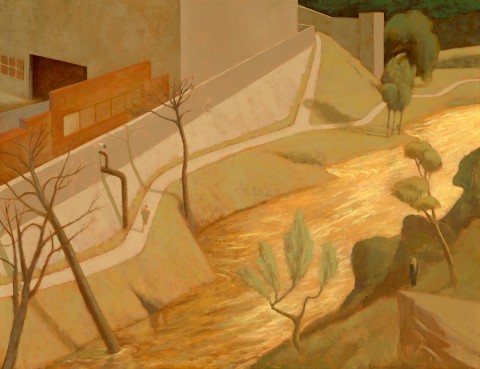THE YARRA RIVER AT ABBOTSFORD, 1989
RICK AMOR
oil on canvas
152.0 x 198.0 cm
signed and dated lower right: RICK AMOR 89
signed and dated verso: Rick Amor / AUG – OCT 89 / 20/10/89 / ...
inscribed with title verso: THE YARRA RIVER / AT ABBOTSFORD
Painted by the artist for the National Australia Bank ‘Rivers in Australian Art Acquisitive Prize’, 1989
The National Australia Bank Art Collection, acquired from the above (as the Prize Winner) in November 1989 (label attached verso)
National Australia Bank Collection: Rivers in Australian Art, Heide Park and Art Gallery, Melbourne, October 1991
The National Australia Bank Art Collection: Rivers in Australian Art, Heide Park and Art Gallery, Melbourne, 1991, p. 10 (illus.)
I've always thought that what we see is not necessarily what's there. There's extra things we don't see, there's layers of reality... The twentieth century seems to be a struggle to relate perception to reality…'1
A consummate painter, sculptor and printmaker with a highly successful career spanning four decades, Rick Amor is the master of transforming the ordinary into the extraordinary. Although drawing inspiration from the seemingly mundane, everyday sites of suburbia and the drab underside of the city, his paintings are typically full of drama, deep melancholy and foreboding – resonating with a disquieting sense of both beauty and menace that alludes to the ambiguities inherent in life and humanity's complex existence. Far from being literal translations, Amor's urban landscapes have evolved, rather, over a number of years, and consequently reveal several layers of memory, knowledge and perception – together with the influence of literature concerning cities from T.S. Eliot's poetic verse to the classic dystopian texts of George Orwell and Franz Kafka. As Paul McGillick observes of Amor's work, ‘…this is a phenomenological process by which the world as we think we see it is actually a construction based only partly on our understanding of it… there is a disconcerting quality to his pictures, as though they were not so much snapshots of reality as frozen frames from the moving pictures of our dreams'.2
As exemplified superbly by The Yarra River at Abbotsford, 1989, a motif frequently punctuating Amor's urban landscapes is that of the solitary individual, alone and dissociated in his environment. Capturing the view from one of the extensive walking trails along the banks of the Yarra River in Abbotsford, an inner suburb of Melbourne, the scene here bears an uncanny sense of déjà vu, of something already experienced. And yet, such familiarity provides the viewer with little comfort or reassurance. To the contrary, the prevailing mood is one of impending doom – the tortured trees, incongruous now in this threatening urbanised environment, cast ominous shadows in the swirling murky waters below, while the two figures, dwarfed in scale and isolated from one another on either side of the river, intensifies the underlying surrealist drama and suspense of the work. Significantly, when discussing the closely related etching entitled Abbotsford, 1990 in the collection of the State Library of Victoria, Amor notes that such compositions were inspired by his revisiting of Otto Benesch’s book, Rembrandt as a Draughtsman (1960) which, gifted to him as a student in 1961, had prompted him to deliberately seek out landscapes reminiscent of those depicted by the Dutch Master.3
Arising from the interplay between of observation and invention, the impulse of memory and dreams, thus Amor’s works such as the present comment imaginatively upon the physical and transient world of which he is a part. Indeed, such is the evocative power and enduring appeal of his vision that – despite being the outward expression of his own inner life – he nevertheless engages the collective unconscious of universal experiences, thoughts and feelings to poignantly reflect upon the complexities of the human condition more broadly. As the artist himself muses, '…the pictures are real to me and I would love to find these places and walk into them. I hope that my world is sometimes as convincing to the viewer as it is to me'.4
1. Amor, R., in Catalano, G., Building a Picture: Interviews with Australian Artists, McGraw Hill, Melbourne, 1997, p. 141
2. McGillick, P., 'The City as Dream - The New York Paintings of Rick Amor', Monument, no. 22, 1998, pp. 84 – 88
3. See: https://catalogue.rickamor.com.au/works/intaglio/abbotsford/
4. Amor, R., On Brack, Bren and Picasso, exhibition catalogue, TarraWarra Museum of Art, Victoria, 2006, n.p.
VERONICA ANGELATOS
